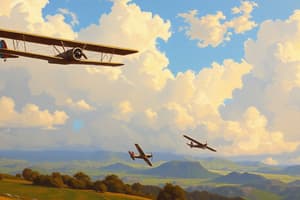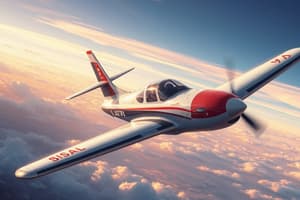Podcast
Questions and Answers
What are the workers in the hangar primarily doing?
What are the workers in the hangar primarily doing?
- Riveting a wing tip (correct)
- Testing metal strength
- Repairing electrical systems
- Painting aircraft
Which method of joining structural elements is mentioned as being less noisy?
Which method of joining structural elements is mentioned as being less noisy?
- Welding
- Gluing
- Bollting (correct)
- All of the above
What type of welding is least likely to be used in aviation metals?
What type of welding is least likely to be used in aviation metals?
- Arc welding
- Cold welding (correct)
- Electron beam welding
- Laser welding
What component is the electrician modifying according to the dialogue?
What component is the electrician modifying according to the dialogue?
What is a significant cause of noise in the aircraft hangar?
What is a significant cause of noise in the aircraft hangar?
Which of the following is not a type of welding mentioned?
Which of the following is not a type of welding mentioned?
What adjustments will the electrician have to do after changing the pot and relay?
What adjustments will the electrician have to do after changing the pot and relay?
What shop is mentioned as one of the various types of workshops in the hangar?
What shop is mentioned as one of the various types of workshops in the hangar?
What type of equipment is referred to as 'avionic equipment'?
What type of equipment is referred to as 'avionic equipment'?
Which of the following is not typically used as a welding technique?
Which of the following is not typically used as a welding technique?
What materials are commonly joined using adhesive connections?
What materials are commonly joined using adhesive connections?
Which of the following operations is essential for completing a bonded connection?
Which of the following operations is essential for completing a bonded connection?
In what context is laser welding primarily applied?
In what context is laser welding primarily applied?
Which term describes a facility for aircraft takeoff and landing?
Which term describes a facility for aircraft takeoff and landing?
Which of the following is not a type of specialized welding?
Which of the following is not a type of specialized welding?
Which of the following tools is essential for completing adhesive connections?
Which of the following tools is essential for completing adhesive connections?
What is a characteristic of the dispatch office in aviation?
What is a characteristic of the dispatch office in aviation?
What might be a task completed during a flight preparation?
What might be a task completed during a flight preparation?
What term refers to the process of removing material through mechanical means?
What term refers to the process of removing material through mechanical means?
Which of the following describes a nonconventional method of machining?
Which of the following describes a nonconventional method of machining?
What does the term 'false alarm' refer to in a technical context?
What does the term 'false alarm' refer to in a technical context?
What is the focus when discussing 'localizing faults' in a system?
What is the focus when discussing 'localizing faults' in a system?
Which of these terms describes the reliability of a pilot's performance?
Which of these terms describes the reliability of a pilot's performance?
In the context of airborne systems, what does the term 'ground' typically refer to?
In the context of airborne systems, what does the term 'ground' typically refer to?
In terms of technical procedures, what does a 'range' typically indicate?
In terms of technical procedures, what does a 'range' typically indicate?
What is a primary concern when dealing with a 'bad' phenomenon during operations?
What is a primary concern when dealing with a 'bad' phenomenon during operations?
What is the main purpose of the tube in the piston engine described?
What is the main purpose of the tube in the piston engine described?
During which stage does fuel get ignited in the piston engine?
During which stage does fuel get ignited in the piston engine?
What does Newton's third law of motion imply in the context of thrust development in engines?
What does Newton's third law of motion imply in the context of thrust development in engines?
How does the exhaust process in the piston engine differ from that in a rocket engine?
How does the exhaust process in the piston engine differ from that in a rocket engine?
What is a key characteristic of reduced observable technology in military aircraft design?
What is a key characteristic of reduced observable technology in military aircraft design?
What does the development of the Advanced Tactical Fighter (ATF) program emphasize?
What does the development of the Advanced Tactical Fighter (ATF) program emphasize?
What is the effect of the widening of the tube in the piston engine on the airflow?
What is the effect of the widening of the tube in the piston engine on the airflow?
What strategic advantage does the use of low observables in military aircraft provide?
What strategic advantage does the use of low observables in military aircraft provide?
What describes the process of mechanical treatment in metal processing?
What describes the process of mechanical treatment in metal processing?
What does the term 'power-to-weight ratio' refer to in engineering terms?
What does the term 'power-to-weight ratio' refer to in engineering terms?
Which reaction principle describes actions in opposite directions?
Which reaction principle describes actions in opposite directions?
What is characterized by the term 'solid joining'?
What is characterized by the term 'solid joining'?
What type of signal is often processed in modern engineering applications?
What type of signal is often processed in modern engineering applications?
In the context of manufacturing, what does 'processor' typically refer to?
In the context of manufacturing, what does 'processor' typically refer to?
What best describes the principle of 'glide-slope' in mechanical systems?
What best describes the principle of 'glide-slope' in mechanical systems?
What role does research play in engineering and manufacturing?
What role does research play in engineering and manufacturing?
Study Notes
Aircraft Overhaul Hangar
- Sheet metal workers are riveting a wing tip and drilling holes in the metal with a pneumatic drill.
- Riveting creates noise, drilling does not.
- Other ways of joining structural elements include bolting, gluing and welding.
- Most aviation metals are weldable due to modern welding techniques
- An electrician is modifying the wiring.
- He is changing the pot, the relay and adjusting the voltage regulators afterwards.
- The type of welding used depends on the type of connection - electron beam welding or solder welding are examples.
- There are many shops in an aircraft hangar besides the ones highlighted, such as the machine shop, paint shop and test shop.
Jet Engine Basics
- Jet engines have four stages: induction, compression, combustion, and exhaust.
- Fuel is injected into a tapered tube, which drives the engine.
- Air flows into the tube during the induction stage.
- The air slows down as the tube widens, which converts kinetic energy to pressure energy and heat during the compression stage
- Fuel is then combusted, which increases temperature.
- The combustion stage produces a small pressure rise because exhaust gas can freely escape through the rear of the tube.
- The exhaust gas escapes into the atmosphere, pushing the engine forwards during the exhaust stage.
Reduced Observables Technology
- Reduced observables technology, also known as stealth technology, is an essential part of modern military aircraft design.
- Military aircraft designers strive to achieve low observables while maintaining a high level of aircraft performance.
- The Advanced Tactical Fighter (ATF) is a type of aircraft that embodies this approach.
- ATF relies on low observables to gain an advantage of surprise rather than relying on stealth as its primary method of survival or mission execution.
Glossary of Terms
- Dispatch office: The area where flight operations and logistics are managed.
- Runway: The strip of ground used for takeoff and landing.
- To take off: To ascend into the air from the runway.
- Tapered tube: A tube that gradually narrows or widens along its length.
- Induction: The process of taking air into a jet engine.
- Compression: The process of increasing the air pressure in a jet engine.
- Combustion: The chemical reaction that releases energy in a jet engine.
- Exhaust: The process of releasing the burnt gases from a jet engine.
- Newton's third law of motion: For every action, there is an equal and opposite reaction.
- Thrust: The force that propels an aircraft forward.
- Reduced observables: Techniques and designs that make an aircraft less visible to radar and other detection systems.
- Stealth technology: A specialized form of reduced observables that aims to make an aircraft nearly invisible to radar and other detection systems.
- Advanced Tactical Fighter (ATF): A type of fighter aircraft that emphasizes low observables for tactical advantage.
- Multi-spindle: A machine with multiple rotating tools that allows simultaneous machining operations.
- Metal alloy: A mixture of two or more metals.
- Powder metallurgy: A process that involves using metal powders to create solid metal components.
- Milling: A machining process that uses rotating cutters to remove material.
- Airborne: Relating to aircraft in flight.
- Ground: Relating to objects or equipment on the ground.
- Pilot: The person who controls an aircraft.
- Personnel: The people who work on an aircraft.
- Probability: The likelihood of an event happening.
- Localization of faults: The process of identifying the specific location of a problem in a system.
- Addressable: Able to be individually accessed or identified.
- Procedure: A set of steps or instructions for carrying out a task.
- Machining: The process of shaping metal components using tools.
- Non-conventional: Not using traditional methods or techniques.
- Electrochemical processing: Using electricity and chemical reactions to modify metal surfaces.
- Electro-erosion: Using electrical discharges to remove material from a metal surface.
- Solid joining: Techniques for creating permanent connections between metal parts.
- Manufacturing: The process of creating goods using various methods.
- Processor: An electronic circuit that performs calculations and processes data.
- Signal: A transmitted or received form of communication.
- Program: A set of instructions that tells a computer what to do.
- Research: The systematic investigation of a subject or phenomenon.
- Propel: To move forward or drive.
- Propeller: A rotating device that creates thrust to move an aircraft.
- Recorder: A device that records data or information.
- Digital: Using or relating to discrete values or digits.
- Glide-slope: A radio beam guidance system that helps aircraft land safely.
- Reaction: A force that occurs in response to another force.
- Equal and opposite: Describing forces that are the same magnitude and in opposite directions.
- Receiver: A device that detects and processes radio signals.
Studying That Suits You
Use AI to generate personalized quizzes and flashcards to suit your learning preferences.
Related Documents
Description
Explore the essentials of aircraft overhaul processes including riveting techniques and electrical modifications. Learn the four stages of jet engines, from induction to exhaust, and the importance of fuel injection in propulsion. Perfect for aviation enthusiasts and students.




